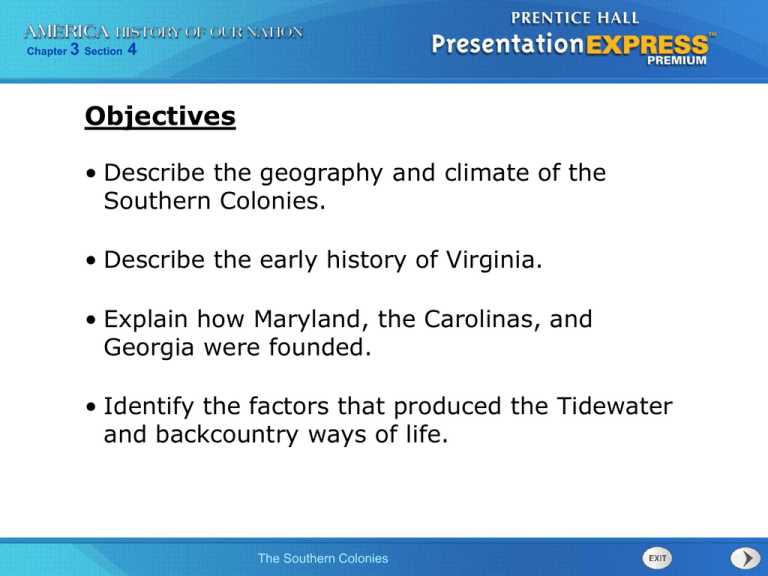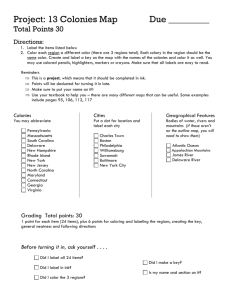Powerpoint Notes 3.4
advertisement

Chapter 3 Section 4 Objectives • Describe the geography and climate of the Southern Colonies. • Describe the early history of Virginia. • Explain how Maryland, the Carolinas, and Georgia were founded. • Identify the factors that produced the Tidewater and backcountry ways of life. The Southern Colonies Chapter 3 Section 4 Terms and People • Nathaniel Bacon – the leader of the frontier settlers who fought “Bacon’s Rebellion,” an attack against Native Americans who were trying to defend their land from colonists • Lord Baltimore – the Catholic proprietor of the Maryland colony who convinced its assembly to pass the Act of Toleration The Southern Colonies Chapter 3 Section 4 Terms and People (continued) • James Oglethorpe – a wealthy Englishman who founded the colony of Georgia, where English debtors would be protected • debtor – a person who owes money • plantation – a large farm The Southern Colonies Chapter 3 Section 4 What factors influenced the development of the Southern Colonies? Maryland, Virginia, North Carolina, South Carolina, and Georgia were Southern Colonies. Factors that influenced the development of these colonies include the climate, the plantation system, religion, and relations with Native Americans. The Southern Colonies Chapter 3 Section 4 Geography of the Southern Colonies Location • These colonies were located south of the Mason-Dixon line, a boundary drawn between Pennsylvania and Maryland. • After the American Revolution, the MasonDixon line was the dividing line between anti-slavery northern states and pro-slavery southern states. Landforms • The Southern Colonies shared a coastal area called the Tidewater, a flat lowland that includes many swampy areas. • On its west, the Tidewater blends into a region of rolling hills called the Piedmont. The Southern Colonies Chapter 3 Section 4 Then and now, the climate of these southern states is warm and humid. These states have a long growing season perfect for crops such as tobacco and rice. The Southern Colonies Chapter 3 Section 4 England’s Southern Colonies, like its other colonies, were founded for various religious and political reasons and for economic opportunities. The Southern Colonies Chapter 3 Section 4 Virginia’s population grew gradually, but by 1670, 40,000 people lived there. By the 1670s, there were more women in Virginia, and more children as well, because fewer were dying at a young age. But as Virginia’s white population grew, the Native American population shrank. The Southern Colonies White Population Native American Population Chapter 3 Section 4 In 1607, there had been 8,000 Native Americans in Virginia, but disease and violence took their toll. By 1675, only 2,000 Native Americans were left. In 1622 and 1644, violence broke out between farmers who wanted more space to plant tobacco and Native Americans trying to defend their land. The Southern Colonies Chapter 3 Section 4 Causes of Bacon’s Rebellion Land and Voting Rights • Poor young white men could not get farmland near the coast because wealthy Virginia tobacco planters bought it all. • Without property, men could not vote. • Many poor colonists moved inland to find good farmland, but they had to fight Native Americans for it. Politics • Poor colonists asked the governor to force the Native Americans to give up their land. • The governor did not want to disrupt the fur trade with Native Americans. The Southern Colonies Chapter 3 Section 4 In 1675, Nathaniel Bacon organized 1,000 settlers to kill Native Americans for their land. Virginia’s governor declared the settlers rebels, and in retaliation Bacon burned Jamestown. Bacon’s Rebellion collapsed when Bacon died, but the governor still could not stop settlers from moving onto Native American lands. The Southern Colonies Chapter 3 Section 4 In 1632, King Charles I granted a charter for a new colony to George Calvert, an English Catholic. Calvert set up the colony of Maryland, where Catholics could live free of the persecution they suffered in England. The first settlers included both Catholics and Protestants. The Southern Colonies Chapter 3 Section 4 When Calvert died, his son Cecil Calvert, Lord Baltimore, became proprietor of the colony. Soon there was tension between Protestants and Catholics, and Lord Baltimore feared Catholics might lose their rights. In 1649, he convinced Maryland’s assembly to pass the Act of Toleration, which welcomed all Christians and gave adult male Christians the right to vote and hold office. The Southern Colonies Chapter 3 Section 4 The Carolina Colony Beginnings • In 1663, King Charles II granted a charter for a new colony called Carolina to be established south of Virginia. Northern Carolina • The northern part of Carolina developed slowly because it had no harbors or rivers. • Settlers grew tobacco on small farms. Southern Carolina • Sugar grew well in the southern part of Carolina, which expanded quickly. • Planters came from Barbados in the West Indies, bringing slaves to grow sugar and rice, which became the area’s most important crop. The Southern Colonies Chapter 3 Section 4 As rice production spread, Carolina’s main city, Charles Town (today’s Charleston) became the biggest city in the Southern Colonies. By then, Carolina had become two colonies: North Carolina and South Carolina. North Carolina Carolina South Carolina The Southern Colonies Chapter 3 Section 4 Georgia, the last of England’s 13 colonies, was founded for two reasons: • An English colony south of Carolina would confine the Spanish to their Florida colony. • A group of wealthy Englishmen led by James Oglethorpe wanted a colony where there would be protection for English debtors. The Southern Colonies Chapter 3 Section 4 Georgia’s founders wanted Georgia to be a colony of small farms, not large plantations, and so slavery was banned. But this restriction was unpopular with settlers and did not last. By the 1750s, slavery was legal in Georgia. The Southern Colonies Chapter 3 Section 4 During the 1700s, the Southern Colonies developed two distinct ways of life. Backcountry Life Plantation Life The backcountry was cut off from the coast and many poor families lived in oneroom shacks on isolated farms. Along the coast, in the Tidewater region, the economy was dominated by wealthy plantations. The Southern Colonies Chapter 3 Section 4 The plantation system began in Virginia and Maryland when settlers began growing tobacco. The Tidewater region in South Carolina and Georgia was well suited for rice. However, rice-growing required many workers to labor in unpleasant conditions, and this was one reason ricefarming helped promote the spread of slavery. The Southern Colonies Chapter 3 Section 4 In time, the enslaved populated outnumbered the free population of South Carolina. The plantation system also divided the white community into: A much larger group of poor people with little or no property who lived in the backcountry South. A small group of wealthy people. The Southern Colonies Chapter 3 Section 4 The backcountry was cut off from the coast by poor roads and long distances. Families lived on isolated farms in shacks, often on land not legally their own. Backcountry people believed colonial governments on the coast cared only about the interests of plantation owners, not about them. The Southern Colonies Chapter 3 Section 4 Section Review QuickTake Quiz The Southern Colonies Know It, Show It Quiz



